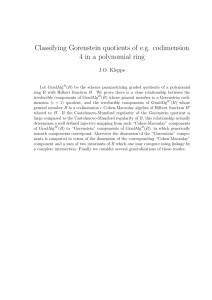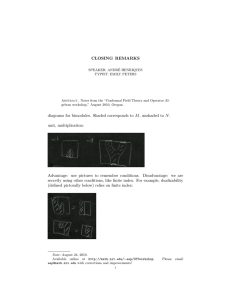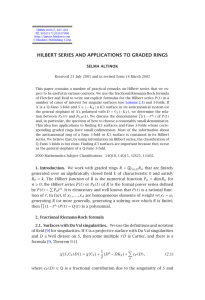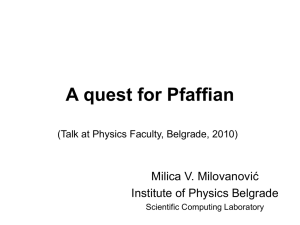F. Tonoli CONSTRUCTION OF CALABI-YAU 3-FOLDS IN Vol. 59, 2 (2001)
advertisement
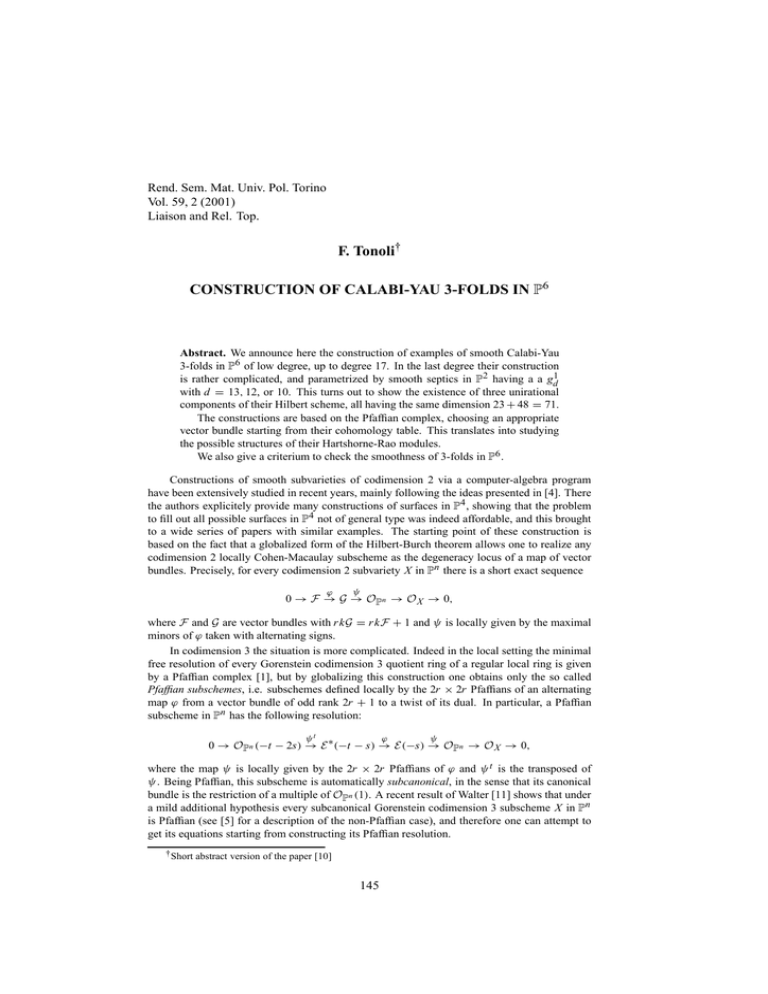
Rend. Sem. Mat. Univ. Pol. Torino Vol. 59, 2 (2001) Liaison and Rel. Top. F. Tonoli† CONSTRUCTION OF CALABI-YAU 3-FOLDS IN P6 Abstract. We announce here the construction of examples of smooth Calabi-Yau 3-folds in P6 of low degree, up to degree 17. In the last degree their construction is rather complicated, and parametrized by smooth septics in P2 having a a gd1 with d = 13, 12, or 10. This turns out to show the existence of three unirational components of their Hilbert scheme, all having the same dimension 23 + 48 = 71. The constructions are based on the Pfaffian complex, choosing an appropriate vector bundle starting from their cohomology table. This translates into studying the possible structures of their Hartshorne-Rao modules. We also give a criterium to check the smoothness of 3-folds in P6 . Constructions of smooth subvarieties of codimension 2 via a computer-algebra program have been extensively studied in recent years, mainly following the ideas presented in [4]. There the authors explicitely provide many constructions of surfaces in P4 , showing that the problem to fill out all possible surfaces in P4 not of general type was indeed affordable, and this brought to a wide series of papers with similar examples. The starting point of these construction is based on the fact that a globalized form of the Hilbert-Burch theorem allows one to realize any codimension 2 locally Cohen-Macaulay subscheme as the degeneracy locus of a map of vector bundles. Precisely, for every codimension 2 subvariety X in Pn there is a short exact sequence ϕ ψ 0 → F → G → OPn → O X → 0, where F and G are vector bundles with r kG = r kF + 1 and ψ is locally given by the maximal minors of ϕ taken with alternating signs. In codimension 3 the situation is more complicated. Indeed in the local setting the minimal free resolution of every Gorenstein codimension 3 quotient ring of a regular local ring is given by a Pfaffian complex [1], but by globalizing this construction one obtains only the so called Pfaffian subschemes, i.e. subschemes defined locally by the 2r × 2r Pfaffians of an alternating map ϕ from a vector bundle of odd rank 2r + 1 to a twist of its dual. In particular, a Pfaffian subscheme in Pn has the following resolution: ψt ϕ ψ 0 → OPn (−t − 2s) → E ∗ (−t − s) → E (−s) → OPn → O X → 0, where the map ψ is locally given by the 2r × 2r Pfaffians of ϕ and ψ t is the transposed of ψ. Being Pfaffian, this subscheme is automatically subcanonical, in the sense that its canonical bundle is the restriction of a multiple of OPn (1). A recent result of Walter [11] shows that under a mild additional hypothesis every subcanonical Gorenstein codimension 3 subscheme X in Pn is Pfaffian (see [5] for a description of the non-Pfaffian case), and therefore one can attempt to get its equations starting from constructing its Pfaffian resolution. † Short abstract version of the paper [10] 145 146 F. Tonoli In [10] we apply this method to build examples of smooth Calabi-Yau 3-folds in P6 . In order to build a Pfaffian resolution of a subcanonical Gorenstein codimension 3 subscheme X, Walter shows an explicit way to choose an appropriate vector bundle, starting from its Hartshorne-Rao modules H∗i (I X ): this is a precise hint for constructing a resolution. But to find out what are the possible structures for such modules is the hard part in the construction: indeed from the invariants of X one can deduce only the “minimal” possible Hilbert functions of its HartshorneRao modules, and their module structures remain obscure. In this sense the problems met in the constructions are the same as in the codimension 2 cases, except that here the range of examples where the construction is straightforward (and their Hilbert scheme component unirational) is rather short. We construct examples of smooth Calabi-Yau 3-folds in P6 having degree d in the range 12 ≤ d ≤ 17. Such a bound can be better understood by looking at hyperplane sections of the desired 3-folds. Since an hyperplane section of a Calabi-Yau 3-fold is a canonical surface, a lower bound on the degree d of the desired 3-fold can be obtained easily by the Castelnuovo inequality: if the canonical map of a surface S is birational, then K S2 ≥ 3 pg − 7, c.f. [3], p. 24. This gives d ≥ 11. Furthermore, the case d = 11 is interesting, but no smooth examples were found and we believe that they don’t exist: every Calabi-Yau threefold contructed has an ordinary double point (A1 type), also over finite fields of high order; thus this seems to be the “general” case. Thus degree 12 seems to be the good starting point. Over degree 17 we don’t know a general way to proceed: even constructing the module becomes too hard. In particular, for degree 18 we were not able to find even the module structure of the canonical surface given by a general hyperplane section of our hypothetical 3-fold (surface which is a smooth codimension 3 subcanonical scheme in P5 and can therefore be constructed in the same way). In all the cases examined the Hartshorne-Rao modules H∗i (I X ) vanish for all 2 ≤ i ≤ 3, and only the module structure of H∗1 (I X ) has to be determined. This structure is unique in the initial cases (up to isomorphisms), but not in the degree 17 case (and in the further cases), where the module has to be chosen in a subtle way, not at all clear at the beginning. In [8] investigations with small finite fields revealed strange properties of these special modules, there searched at random with a computer-algebra program. In [10] we give a more detailed analysis of the problem, which provides a completely unexpected geometric method to produce unirational families of these modules: at the end we obtain three unirational families, in which the desired modules are reconstructed starting from a smooth septic curve in P2 endowed with a complete linear series gd1 having degree d = 13, 12, 10 respectively. This strong result, together with the analysis which brought us to it, gives easily the following theorem, which is the main result of [10]. T HEOREM 1. The Hilbert Scheme of smooth Calabi-Yau 3-folds of degree 17 in P6 has at least three irreducible connected components. These three components are reduced, unirational, and have dimension 23 + 48. The corresponding Calabi-Yau 3-folds differ in the number of quintic generators of their homogemeous ideals, which are 8, 9 and 11 respectively. Note that it is enough to prove the irreducibility of the three families, since it is well known by the work of Bogomolov [2] and Tian [9] (c.f. also the recent results of Ran [7] and [6]), that the universal local family of the deformations of a Calabi-Yau manifold is smooth. We develope also a criterium for checking the smoothness of 3-folds in P6 , which is computationally affordable, and by far faster than the Jacobian criterium. Indeed the check is subdivided in different steps, each one involving the computation of fewer minors of the Jacobian matrix and a Gröbner basis of ideals with lower codimensions. Construction of Calabi-Yau 3-folds in P6 147 Notation. Let S = K [x0 , . . . , x6 ] be the homogeneous coordinate ring of P6 and f1 , . . . , f N a set of homogeneous polynomial such that I := h f 1 , . . . , f N i is the ideal of a codimension 3 variety X ⊂ P6 . We denote with D ∂f E i J := 1 ≤ i ≤ N, 0 ≤ j ≤ 6 ∂x j the jacobian ideal of I and with Ik (J ) the ideal of the k × k minors of J . Moreover, we denote with J≤e the part of the jacobian matrix formed by the rows of J having degree ≤ e and by Ik (J )≤e for the k × k minors of J≤e . If f1 , . . . , fn are different generators of I , we write Ik (J ( f 1 , . . . , f n )) for the k × k minors of the jacobian ideal of ( f 1 , . . . , f n ), and with Ik ( f1 , . . . , fn ) (resp. Ik ( f 1 , . . . , f n )≤e ) for the ideal of the k × k minors of J (resp. J≤e ) which involve the rows corresponding to f 1 , . . . , f n . Notation. If e ∈ N is a positive integer, we denote with Ne and Pe (t) the integer and the polynomial defined by: Ne :=c3 (N X∗ (e)); Pe (t) := deg c2 (N X∗ (e)) t + χ(O X ) + χ(2O X (−c1 (N X∗ ) − 3e))+ − χ(N X∗ (−c1 (N X∗ ) − 2e)). Moreover, given a variety Z ⊂ P6 denote with H P(Z) its Hilbert polynomial. T HEOREM 2. Let X ⊂ P6 be a locally Gorenstein 3-fold and f, g two generators of I having degree e. Suppose that X has at most a finite set of singular points and that ( i ) V ((I1 (J )≤e + I ) = ∅, ( ii ) V (I2 (g)≤e + I ) is finite and deg V (I2 (g)≤e + I ) = deg V (J (g) + I ) = Ne ; ( iii ) V (I3 ( f, g) + I ) is a curve and H P(V (I3 ( f, g) + I )) = H P(V (I2 (J ( f, g)) + I )) = Pe (t). Then X is smooth. References [1] B UCHSBAUM D. A. AND E ISENBUD D., Algebra structures for finite free resolutions, and some structure theorems for ideals of codimension 3, Am. J. Math. 99 (1977), 447–485. [2] B OGOMOLOV F.A., Hamiltonian Kähler manifolds, Sov. Math. Doklady 19 (1978), 1462– 1465. [3] C ATANESE F., Homological algebra and algebraic surfaces, A.M.S. Proc. Symp. Pure Math. 62 (1997), 3–56. [4] D ECKER W., E IN L. AND S CHREYER F.O., Construction of surfaces in P4 , J. Alg. Geom. 12 (1993), 185–237. [5] E ISENBUD D., P OPESCU S. AND WALTER C., Lagrangian subbundles and codimension 3 subcanonical subschemes, Duke Math. J. 107 (2001), 427–467. 148 F. Tonoli [6] K AWAMATA Y., Unobstructed deformations – a remark on a paper of Z. Ran, J. Alg. Geom. 1 (1992), 183–190; erratum ibid. 6 (1997), 803–804. [7] R AN Z., Deformations of manifolds with torsion or negative canonical bundle, J. Alg. Geom. 1 (1992), 279–291. [8] S CHREYER F.O. AND T ONOLI F., Needles in a haystack: special varieties via small fields, in: “Computations in algebraic geometry with Macaulay2” (Eds. Eisenbud et al.), Algorithms and Computation in Mathematics 8, Springer-Verlag 2002. [9] T IAN G., Smoothness of the univeral deformation space of compact Calabi-Yau manifolds and its Peterson-Weil metric, in: “Mathematical aspects of string theory” (Ed. Yau S.T.), 629–646, World Scientific Press, Singapore 1987. [10] T ONOLI F., Construction of Calabi-Yau 3-folds in P6 , preprint (2001). [11] WALTER C., Pfaffian subschemes, J. Alg. Geom. 5 (1996), 671–704. AMS Subject Classification: 14J10, 14J32 Fabio TONOLI Lehrstuhl Mathematik VIII Fakultät für Mathematik und Physik Universität Bayreuth D–95440 Bayreuth, GERMANY e-mail: Fabio.Tonoli@uni-bayreuth.de
